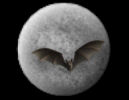|
Hi Alan,
Thank you.
It seems that without changing structure we cannot model everything. For example equation x=y*z establishes certain connections between x, y and z, but we cannot write any equation so that it for example will create new variable n and establish new connections between x and n etc, in equations such topology is established once and remains such forever. We can implement Turing machine though with equations (but only with iterative equations) because it is a state machine, and Turing machine can implement all processes, but then such equation doesn't model all processes the way they happen in nature because Turing machine implements processes sequantially while in nature they happen massively simultaneously.
I maintain the derivation in my web page exactly how I once did it, I think I would modify it a bit if I wrote it now. First the dimensions were just a thought experiment. If we come from constructing dimensions (a theory developed in Harvard university) and say that all dimensions can be constructed, then in space with no dimensions there also cannot be anything else than points (with zero dimensions) connected to each other (with connections with no properties). Now everything else comes from the condition that the structure must change (what is everything what *can* change there) and it was derived to be the only (simple) possibility for that what enables any change. Concerning cellular automata there are patterns what develop forever but only if there is a single such pattern in the whole space, ADS survive a long time in very random conditions.
Absolutely dynamic systems (ADS) are not exactly based on Chris Langan's interpretation of consciousness because they are not based on language, language may come only from emerging processes. Also the only thing I saw in common with Hawking's "nuts and bolts" was that the points there also have zero dimensions. But there certainly may be similarities because ADS are derived from the most common principles. Consider this part of my derivation:
> "It can be that both the new knot and the adjacent knot are connected with the same knot, but there can also be no common knot with what both the new knot and the adjacent knot are connected with. This is the simplest possibility to make a distinction between the pairs mentioned above."
> Brilliant!!!!!!!!!!!!!!!!!!!!!!!!!!!!!!!!!!!!!!!!!
> Exactly what I found and what I think Chris Langan found!
This may indeed appear in many theories because this is the most common principle - to find common between two sets. This is the form in what it appears in my derivation. What else comes from it is that if we connect the *different* (not common), we get association and this is the most basic process the ADS are based on.
> The learned words would be understood in the system's own language; it might build up more understanding in further developing its internal language?
If there would develop a language. I taught it only as much as it was necessary for testing the program and I didn't even try to teach it more. The problem is that there is not yet any theory on how to teach a system what knows almost nothing. This seems to be a simple problem as we all think that we can teach, but it isn't. If we try to teach it just by interacting, then it would take too much time. So we must write a "teaching program" what does exactly the same, but for that we need some theory of how to write it, what most likely would come from the principle that such system tries to act so that it can predict the results of its action. So the problem of such "teaching algorithm" is much more complicated than it may seem to be.
You and some others seem to know more about physics than I do. This is why I'm somewhat reluctant to develop any principles of how physical systems may be modelled with ADS. What I did was not physics and so whatever may be related to physics in a way or another, I don't want to argue that things *are* in one way or another so that others may just say whether it is right or wrong, or to go in wrong direction. So it's better that people who know more about physics develop theories in physics, even if such models like ADS may be useful for that. It seems that there is at least someone who likes one idea what comes out of it, that propagation of light is a propagation of a process. One thing why it is hard to talk about ADS or anything else what is based on very general principles is that it may be as talking about the whole world. I'm sorry that I didn't comment everything what you said, I think many things were correct, but it's just impossible to talk about everything at once.
Tarvo |



